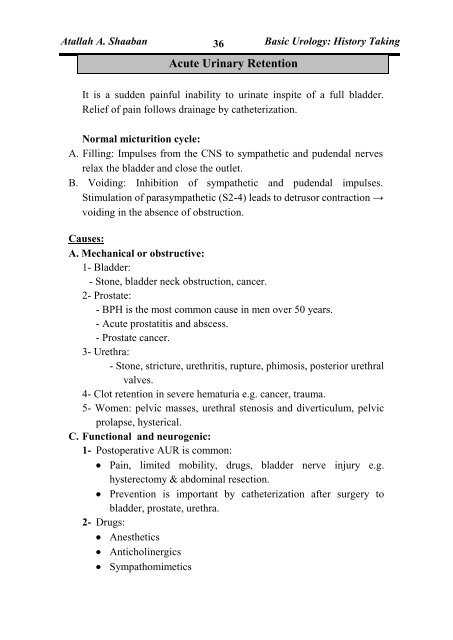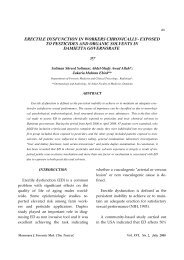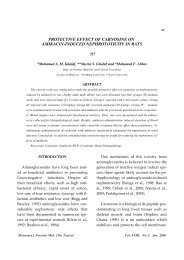You also want an ePaper? Increase the reach of your titles
YUMPU automatically turns print PDFs into web optimized ePapers that Google loves.
Atallah A. Shaaban<br />
36<br />
Acute Urinary Retention<br />
<strong>Basic</strong> <strong>Urology</strong>: History Taking<br />
It is a sudden painful inability to urinate inspite of a full bladder.<br />
Relief of pain follows drainage by catheterization.<br />
Normal micturition cycle:<br />
A. Filling: Impulses from the CNS to sympathetic and pudendal nerves<br />
relax the bladder and close the outlet.<br />
B. Voiding: Inhibition of sympathetic and pudendal impulses.<br />
Stimulation of parasympathetic (S2-4) leads to detrusor contraction →<br />
voiding in the absence of obstruction.<br />
Causes:<br />
A. Mechanical or obstructive:<br />
1- Bladder:<br />
- Stone, bladder neck obstruction, cancer.<br />
2- Prostate:<br />
- BPH is the most common cause in men over 50 years.<br />
- Acute prostatitis and abscess.<br />
- Prostate cancer.<br />
3- Urethra:<br />
- Stone, stricture, urethritis, rupture, phimosis, posterior urethral<br />
valves.<br />
4- Clot retention in severe hematuria e.g. cancer, trauma.<br />
5- Women: pelvic masses, urethral stenosis and diverticulum, pelvic<br />
prolapse, hysterical.<br />
C. Functional and neurogenic:<br />
1- Postoperative AUR is common:<br />
Pain, limited mobility, drugs, bladder nerve injury e.g.<br />
hysterectomy & abdominal resection.<br />
Prevention is important by catheterization after surgery to<br />
bladder, prostate, urethra.<br />
2- Drugs:<br />
Anesthetics<br />
Anticholinergics<br />
Sympathomimetics




